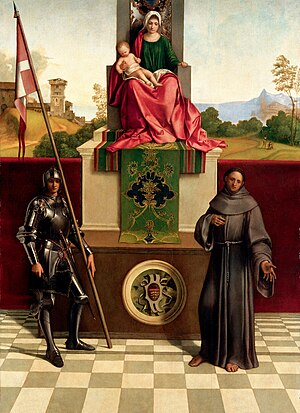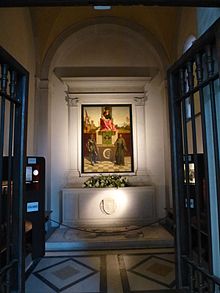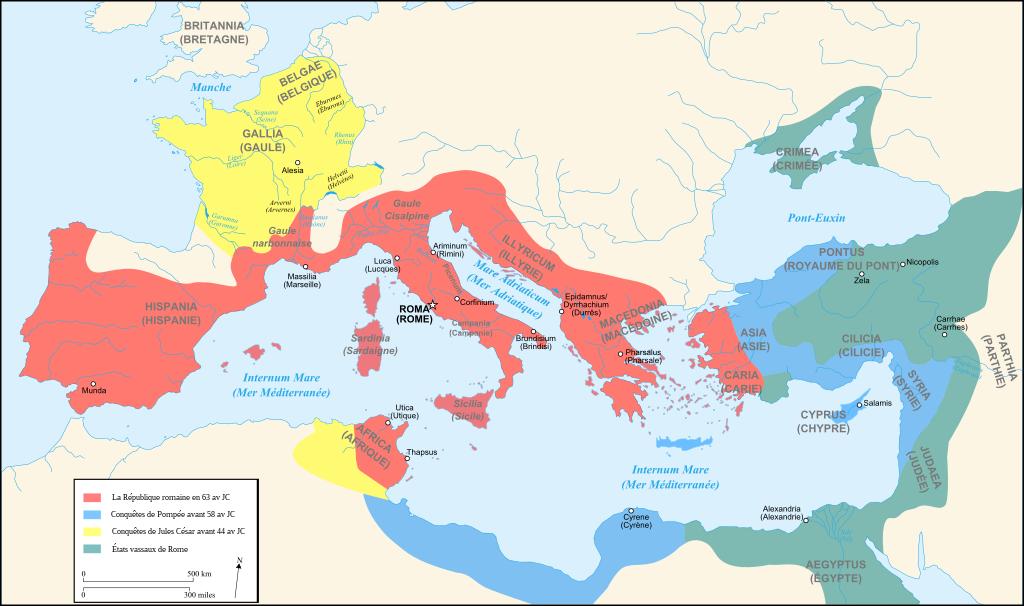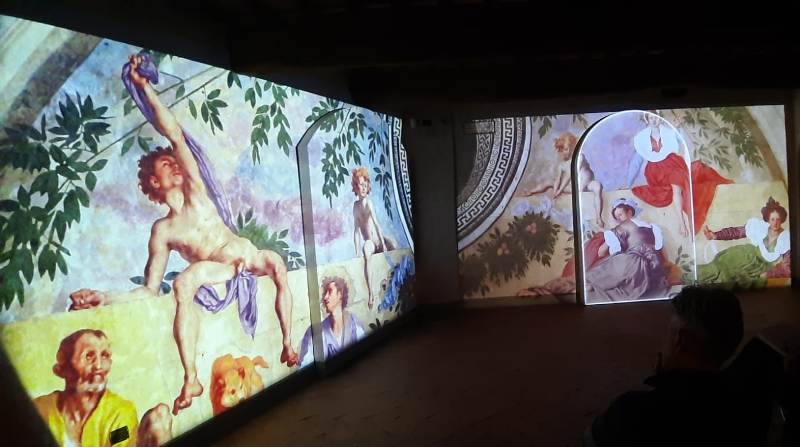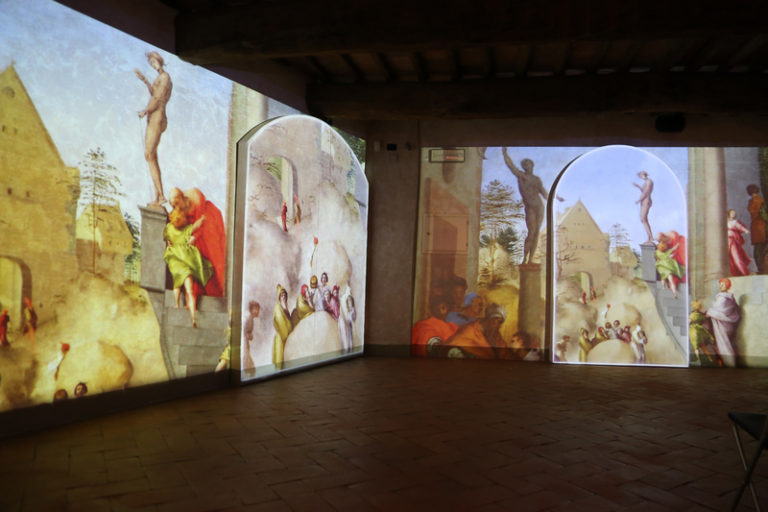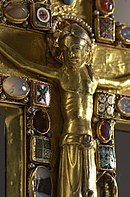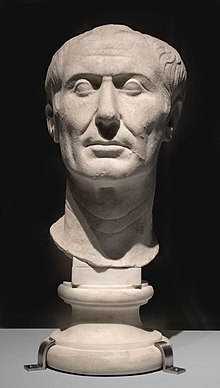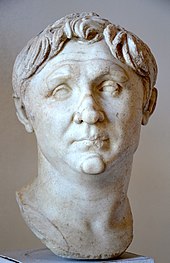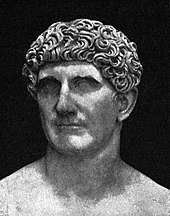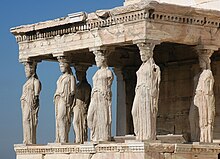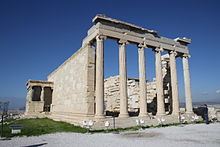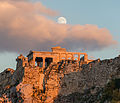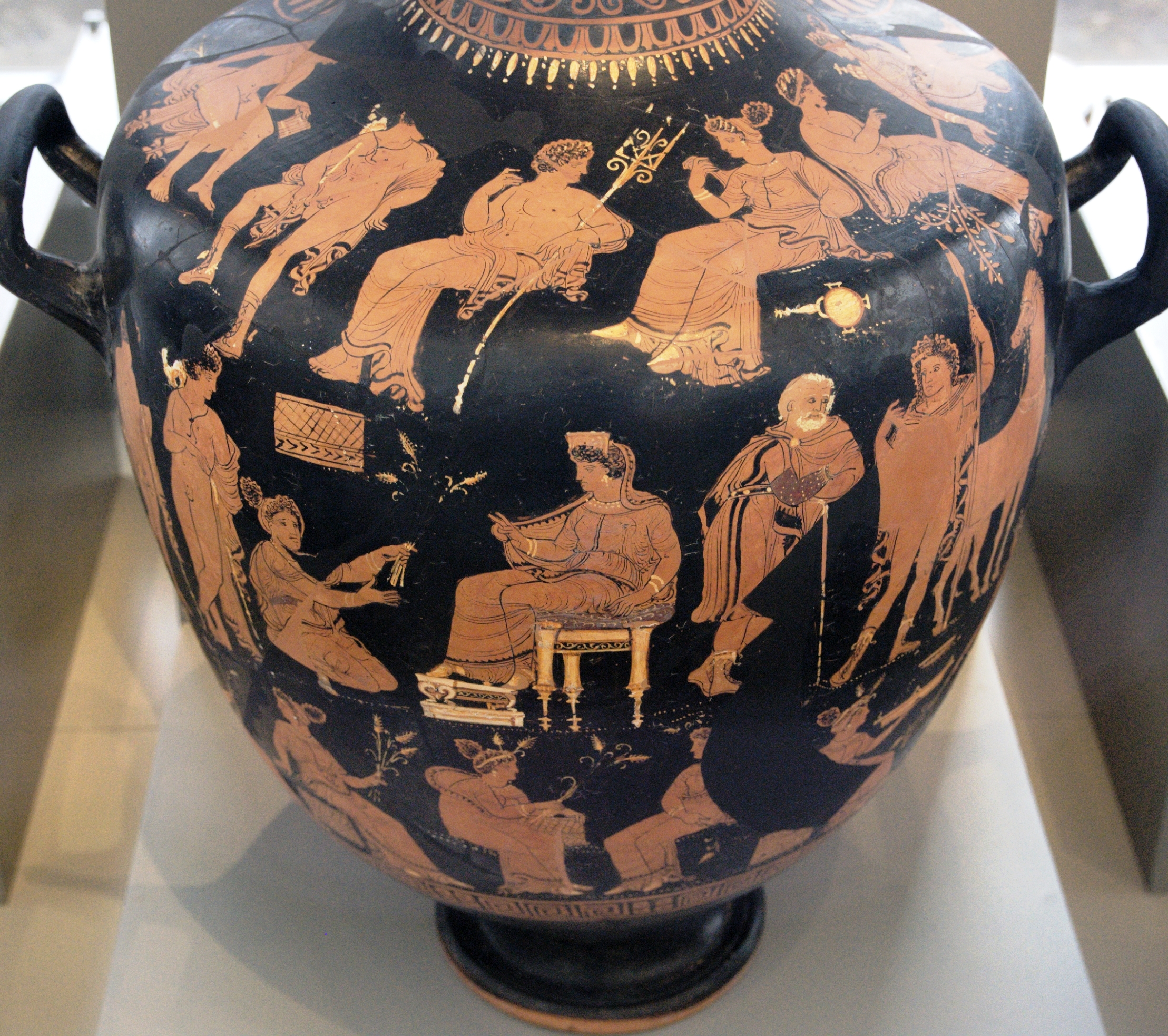Giacobbe Giusti, Julius Caesar
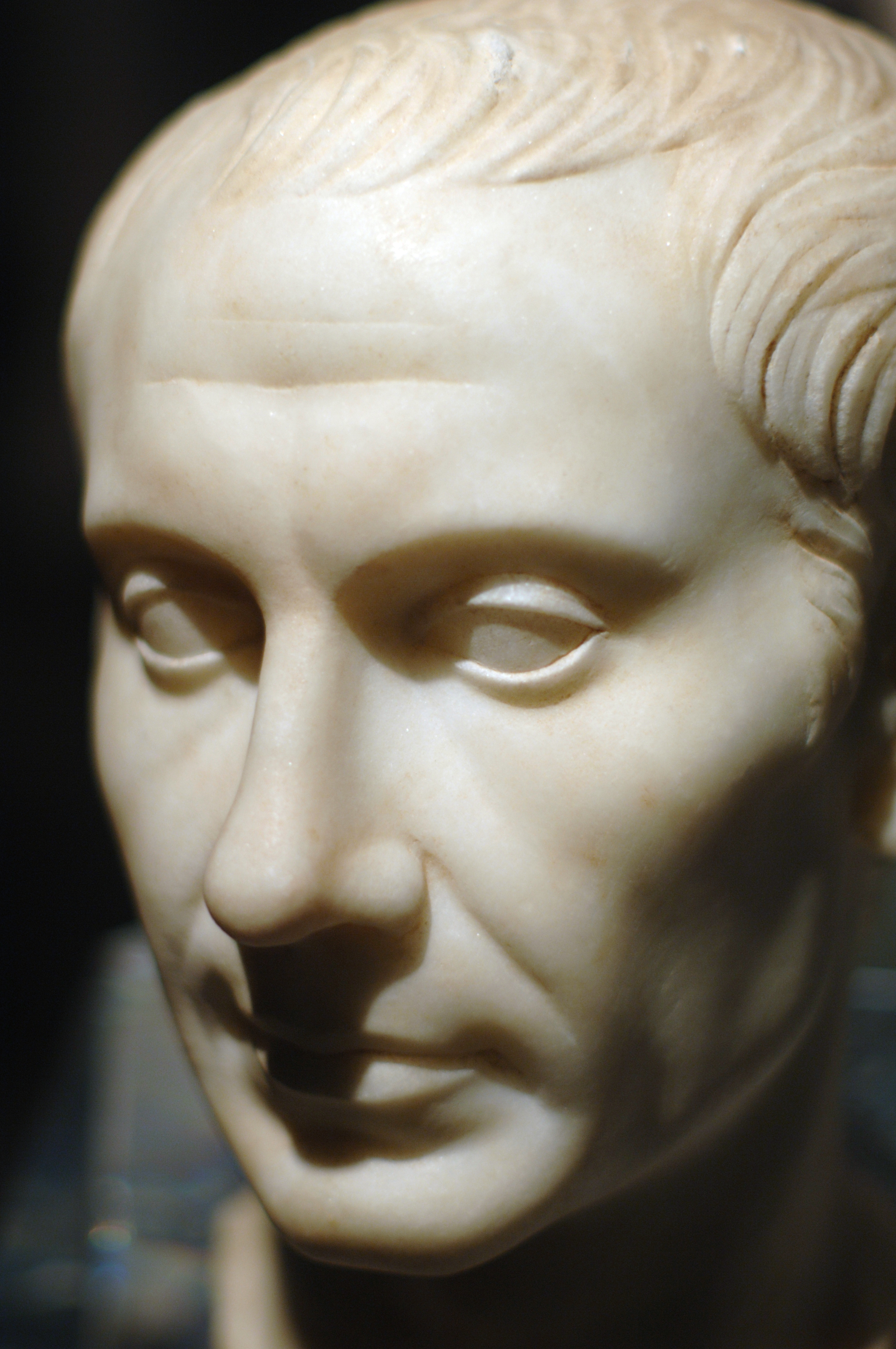
User:Euthman
Giacobbe Giusti, Julius Caesar

Creating User:Leomudde
Giacobbe Giusti, Julius Caesar

Bust of Julius Caesar, posthumous portrait in marble, 44–30 BC, Museo Pio-Clementino, Vatican Museums
Giacobbe Giusti, Julius Caesar

Giacobbe Giusti, Julius Caesar
Gaius Julius Caesar[a] (; Latin pronunciation: [ˈɡaː.i.ʊs ˈjuː.li.ʊs ˈkae̯.sar]; 12 or 13 July 100 BC[1] – 15 March 44 BC),[2] known by his nomenand cognomen Julius Caesar, was a Roman politician, military general, and historian who played a critical role in the events that led to the demise of the Roman Republic and the rise of the Roman Empire. He also wrote Latinprose.
In 60 BC, Caesar, Crassus and Pompey formed the First Triumvirate, a political alliance that dominated Roman politics for several years. Their attempts to amass power as Populareswere opposed by the Optimates within the Roman Senate, among them Cato the Younger with the frequent support of Cicero. Caesar rose to become one of the most powerful politicians in the Roman Republic through a number of his accomplishments, notably his victories in the Gallic Wars, completed by 51 BC. During this time, Caesar became the first Roman general to cross both the English Channel and the Rhine River, when he built a bridge across the Rhine and crossed the Channel to invade Britain. Caesar’s wars extended Rome’s territory to Britain and past Gaul. These achievements granted him unmatched military power and threatened to eclipse the standing of Pompey, who had realigned himself with the Senate after the death of Crassus in 53 BC. With the Gallic Wars concluded, the Senate ordered Caesar to step down from his military command and return to Rome. Leaving his command in Gaul meant losing his immunity from being charged as a criminal for waging unsanctioned wars. As a result, Caesar found himself with no other options but to cross the Rubicon with the 13th Legion, leaving his province and illegally entering Roman Italy under arms.[3] This began Caesar’s civil war, and his victory in the war put him in an unrivaled position of power and influence.
After assuming control of government, Caesar began a program of social and governmental reforms, including the creation of the Julian calendar. He gave citizenship to many residents of far regions of the Roman Empire. He initiated land reform and support for veterans. He centralized the bureaucracy of the Republic and was eventually proclaimed “dictator for life” (Latin: “dictator perpetuo“), giving him additional authority. His populist and authoritarian reforms angered the elites, who began to conspire against him. On the Ides of March (15 March), 44 BC, Caesar was assassinated by a group of rebellious senators led by Gaius Cassius Longinus, Marcus Junius Brutus and Decimus Junius Brutus, who stabbed him to death.[4][5]A new series of civil wars broke out and the constitutional government of the Republic was never fully restored. Caesar’s adopted heir Octavian, later known as Augustus, rose to sole power after defeating his opponents in the civil war. Octavian set about solidifying his power, and the era of the Roman Empirebegan.
Much of Caesar’s life is known from his own accounts of his military campaigns and from other contemporary sources, mainly the letters and speeches of Cicero and the historical writings of Sallust. The later biographies of Caesar by Suetonius and Plutarch are also major sources. Caesar is considered by many historians to be one of the greatest military commanders in history.[6] His cognomen was subsequently adopted as a synonym for “Emperor”; the title “Caesar” was used throughout the Roman Empire, giving rise to modern cognates such as Kaiser or Tsar. He has frequently appeared in literary and artistic works, and his political philosophy, known as Caesarism, inspired politicians into the modern era.
Early life and career
Giacobbe Giusti, Julius Caesar
Gaius Julius Caesar was born into a patrician family, the gens Julia, which claimed descent from Iulus, son of the legendary Trojan prince Aeneas, supposedly the son of the goddess Venus.[7] The Julii were of Alban origin, mentioned as one of the leading Alban houses, which settled in Rome around the mid-7th century BC, after the destruction of Alba Longa. They were granted patrician status, along with other noble Alban families. [8] The Julii also existed at an early period at Bovillae, evidenced by a very ancient inscription on an altar in the theatre of that town, which speaks of their offering sacrifices according to the lege Albana, or Alban rites.[9] The cognomen “Caesar” originated, according to Pliny the Elder, with an ancestor who was born by Caesarean section (from the Latin verb to cut, caedere, caes-).[10] The Historia Augusta suggests three alternative explanations: that the first Caesar had a thick head of hair (Latin caesaries); that he had bright grey eyes (Latin oculis caesiis); or that he killed an elephant (caesai in Moorish) in battle.[11] Caesar issued coins featuring images of elephants, suggesting that he favored this interpretation of his name.
Despite their ancient pedigree, the Julii Caesares were not especially politically influential, although they had enjoyed some revival of their political fortunes in the early 1st century BC.[12] Caesar’s father, also called Gaius Julius Caesar, governed the province of Asia,[13] and his sister Julia, Caesar’s aunt, married Gaius Marius, one of the most prominent figures in the Republic.[14] His mother, Aurelia Cotta, came from an influential family. Little is recorded of Caesar’s childhood.[15]
In 85 BC, Caesar’s father died suddenly,[16] so Caesar was the head of the family at 16. His coming of age coincided with a civil war between his uncle Gaius Marius and his rival Lucius Cornelius Sulla. Both sides carried out bloody purges of their political opponents whenever they were in the ascendancy. Marius and his ally Lucius Cornelius Cinna were in control of the city when Caesar was nominated as the new Flamen Dialis (high priest of Jupiter),[17] and he was married to Cinna’s daughter Cornelia.[18][19]
Following Sulla’s final victory, though, Caesar’s connections to the old regime made him a target for the new one. He was stripped of his inheritance, his wife’s dowry, and his priesthood, but he refused to divorce Cornelia and was forced to go into hiding.[20] The threat against him was lifted by the intervention of his mother’s family, which included supporters of Sulla, and the Vestal Virgins. Sulla gave in reluctantly and is said to have declared that he saw many a Marius in Caesar.[15] The loss of his priesthood had allowed him to pursue a military career, as the high priest of Jupiter was not permitted to touch a horse, sleep three nights outside his own bed or one night outside Rome, or look upon an army.[21]
Caesar felt that it would be much safer far away from Sulla should the Dictator change his mind, so he left Rome and joined the army, serving under Marcus Minucius Thermus in Asia and Servilius Isauricus in Cilicia. He served with distinction, winning the Civic Crown for his part in the Siege of Mytilene. He went on a mission to Bithynia to secure the assistance of King Nicomedes‘s fleet, but he spent so long at Nicomedes’ court that rumours arose of an affair with the king, which Caesar vehemently denied for the rest of his life.[22]
Hearing of Sulla’s death in 78 BC, Caesar felt safe enough to return to Rome. He lacked means since his inheritance was confiscated, but he acquired a modest house in Subura, a lower-class neighbourhood of Rome.[23] He turned to legal advocacy and became known for his exceptional oratory accompanied by impassioned gestures and a high-pitched voice, and ruthless prosecution of former governors notorious for extortion and corruption.
Giacobbe Giusti, Julius Caesar
On the way across the Aegean Sea,[24] Caesar was kidnapped by pirates and held prisoner.[25][26] He maintained an attitude of superiority throughout his captivity. The pirates demanded a ransom of 20 talents of silver, but he insisted that they ask for 50.[27][28] After the ransom was paid, Caesar raised a fleet, pursued and captured the pirates, and imprisoned them. He had them crucified on his own authority, as he had promised while in captivity[29]—a promise that the pirates had taken as a joke. As a sign of leniency, he first had their throats cut. He was soon called back into military action in Asia, raising a band of auxiliaries to repel an incursion from the east.[30]
On his return to Rome, he was elected military tribune, a first step in a political career. He was elected quaestor for 69 BC,[31] and during that year he delivered the funeral oration for his aunt Julia, and included images of her husband Marius in the funeral procession, unseen since the days of Sulla. His wife Cornelia also died that year.[32]Caesar went to serve his quaestorship in Spain after her funeral, in the spring or early summer of 69 BC.[33] While there, he is said to have encountered a statue of Alexander the Great, and realised with dissatisfaction that he was now at an age when Alexander had the world at his feet, while he had achieved comparatively little. On his return in 67 BC,[34] he married Pompeia, a granddaughter of Sulla, whom he later divorced in 61 BC after her embroilment in the Bona Dea scandal.[35] In 65 BC, he was elected curule aedile, and staged lavish games that won him further attention and popular support.[36]
In 63 BC, he ran for election to the post of Pontifex Maximus, chief priest of the Roman state religion. He ran against two powerful senators. Accusations of bribery were made by all sides. Caesar won comfortably, despite his opponents’ greater experience and standing.[37] Cicero was consul that year, and he exposed Catiline‘s conspiracy to seize control of the republic; several senators accused Caesar of involvement in the plot.[38]
After serving as praetor in 62 BC, Caesar was appointed to govern Hispania Ulterior(modern south-eastern Spain) as propraetor,[39][40][41] though some sources suggest that he held proconsular powers.[42][43] He was still in considerable debt and needed to satisfy his creditors before he could leave. He turned to Marcus Licinius Crassus, one of Rome’s richest men. Crassus paid some of Caesar’s debts and acted as guarantor for others, in return for political support in his opposition to the interests of Pompey. Even so, to avoid becoming a private citizen and thus open to prosecution for his debts, Caesar left for his province before his praetorship had ended. In Spain, he conquered two local tribes and was hailed as imperator by his troops; he reformed the law regarding debts, and completed his governorship in high esteem.[44]
Caesar was acclaimed Imperator in 60 and 45 BC. In the Roman Republic, this was an honorary title assumed by certain military commanders. After an especially great victory, army troops in the field would proclaim their commander imperator, an acclamation necessary for a general to apply to the Senate for a triumph. However, he also wanted to stand for consul, the most senior magistracy in the republic. If he were to celebrate a triumph, he would have to remain a soldier and stay outside the city until the ceremony, but to stand for election he would need to lay down his command and enter Rome as a private citizen. He could not do both in the time available. He asked the senate for permission to stand in absentia, but Cato blocked the proposal. Faced with the choice between a triumph and the consulship, Caesar chose the consulship.[45]
Consulship and military campaigns
Giacobbe Giusti, Julius Caesar
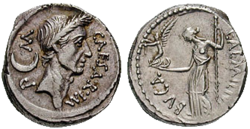
A denarius depicting Julius Caesar, dated February–March 44 BC—the goddess Venus is shown on the reverse, holding Victoria and a scepter. Caption: CAESAR IMP. M. / L. AEMILIVS BVCA
Giacobbe Giusti, Julius Caesar
In 60 BC, Caesar sought election as consul for 59 BC, along with two other candidates. The election was sordid – even Cato, with his reputation for incorruptibility, is said to have resorted to bribery in favour of one of Caesar’s opponents. Caesar won, along with conservative Marcus Bibulus.[46]
Caesar was already in Crassus‘ political debt, but he also made overtures to Pompey. Pompey and Crassus had been at odds for a decade, so Caesar tried to reconcile them. The three of them had enough money and political influence to control public business. This informal alliance, known as the First Triumvirate (“rule of three men”), was cemented by the marriage of Pompey to Caesar’s daughter Julia.[47] Caesar also married again, this time Calpurnia, who was the daughter of another powerful senator.[48]
Caesar proposed a law for redistributing public lands to the poor—by force of arms, if need be—a proposal supported by Pompey and by Crassus, making the triumvirate public. Pompey filled the city with soldiers, a move which intimidated the triumvirate’s opponents. Bibulus attempted to declare the omens unfavourable and thus void the new law, but he was driven from the forum by Caesar’s armed supporters. His lictors had their fasces broken, two high magistrates accompanying him were wounded, and he had a bucket of excrement thrown over him. In fear of his life, he retired to his house for the rest of the year, issuing occasional proclamations of bad omens. These attempts proved ineffective in obstructing Caesar’s legislation. Roman satirists ever after referred to the year as “the consulship of Julius and Caesar.”[49]
When Caesar was first elected, the aristocracy tried to limit his future power by allotting the woods and pastures of Italy, rather than the governorship of a province, as his military command duty after his year in office was over.[50] With the help of political allies, Caesar later overturned this, and was instead appointed to govern Cisalpine Gaul (northern Italy) and Illyricum (southeastern Europe), with Transalpine Gaul (southern France) later added, giving him command of four legions. The term of his governorship, and thus his immunity from prosecution, was set at five years, rather than the usual one.[51] When his consulship ended, Caesar narrowly avoided prosecution for the irregularities of his year in office, and quickly left for his province.[52]
Conquest of Gaul
Giacobbe Giusti, Julius Caesar

The extent of the Roman Republic in 40 BC after Caesar’s conquests
Caesar was still deeply in debt, but there was money to be made as a governor, whether by extortion[53] or by military adventurism. Caesar had four legions under his command, two of his provinces bordered on unconquered territory, and parts of Gaul were known to be unstable. Some of Rome’s Gallic allies had been defeated by their rivals at the Battle of Magetobriga, with the help of a contingent of Germanic tribes. The Romans feared these tribes were preparing to migrate south, closer to Italy, and that they had warlike intent. Caesar raised two new legions and defeated these tribes.[54]
In response to Caesar’s earlier activities, the tribes in the north-east began to arm themselves. Caesar treated this as an aggressive move and, after an inconclusive engagement against the united tribes, he conquered the tribes piecemeal. Meanwhile, one of his legions began the conquest of the tribes in the far north, directly opposite Britain.[55] During the spring of 56 BC, the Triumvirs held a conference, as Rome was in turmoil and Caesar’s political alliance was coming undone. The Lucca Conference renewed the First Triumvirate and extended Caesar’s governorship for another five years.[56] The conquest of the north was soon completed, while a few pockets of resistance remained.[57] Caesar now had a secure base from which to launch an invasion of Britain.
In 55 BC, Caesar repelled an incursion into Gaul by two Germanic tribes, and followed it up by building a bridge across the Rhine and making a show of force in Germanic territory, before returning and dismantling the bridge. Late that summer, having subdued two other tribes, he crossed into Britain, claiming that the Britons had aided one of his enemies the previous year, possibly the Veneti of Brittany.[58]His intelligence information was poor, and although he gained a beachhead on the coast, he could not advance further, and returned to Gaul for the winter.[59] He returned the following year, better prepared and with a larger force, and achieved more. He advanced inland, and established a few alliances. However, poor harvests led to widespread revolt in Gaul, which forced Caesar to leave Britain for the last time.[60]
Giacobbe Giusti, Julius Caesar
While Caesar was in Britain his daughter Julia, Pompey’s wife, had died in childbirth. Caesar tried to re-secure Pompey’s support by offering him his great-niece in marriage, but Pompey declined. In 53 BC Crassus was killed leading a failed invasion of the east. Rome was on the brink of civil war. Pompey was appointed sole consul as an emergency measure, and married the daughter of a political opponent of Caesar. The Triumvirate was dead.[61]
Though the Gallic tribes were just as strong as the Romans militarily, the internal division among the Gauls guaranteed an easy victory for Caesar. Vercingetorix‘s attempt in 52 BC to unite them against Roman invasion came too late.[62][63] He proved an astute commander, defeating Caesar in several engagements, but Caesar’s elaborate siege-works at the Battle of Alesia finally forced his surrender.[64]Despite scattered outbreaks of warfare the following year,[65] Gaul was effectively conquered. Plutarch claimed that during the Gallic Wars the army had fought against three million men (of whom one million died, and another million were enslaved), subjugated 300 tribes, and destroyed 800 cities.[66]
Civil war
Giacobbe Giusti, Julius Caesar
In 50 BC, the Senate (led by Pompey) ordered Caesar to disband his army and return to Rome because his term as governor had finished.[67]Caesar thought he would be prosecuted if he entered Rome without the immunity enjoyed by a magistrate. Pompey accused Caesar of insubordination and treason. On 10 January 49 BC, Caesar crossed the Rubicon river (the frontier boundary of Italy) with only a single legion, the Legio XIII Gemina, and ignited civil war. Upon crossing the Rubicon, Caesar, according to Plutarch and Suetonius, is supposed to have quoted the Athenian playwright Menander, in Greek, “the die is cast“.[68]Erasmus, however, notes that the more accurate Latin translation of the Greek imperative mood would be “alea iacta esto“, let the die be cast.[69] Pompey and many of the Senate fled to the south, having little confidence in Pompey’s newly raised troops. Pompey, despite greatly outnumbering Caesar, who only had his Thirteenth Legion with him, did not intend to fight. Caesar pursued Pompey, hoping to capture Pompey before his legions could escape.[70]
Pompey managed to escape before Caesar could capture him. Heading for Spain, Caesar left Italy under the control of Mark Antony. After an astonishing 27-day route-march, Caesar defeated Pompey’s lieutenants, then returned east, to challenge Pompey in Illyria, where, in July 48 BC in the battle of Dyrrhachium, Caesar barely avoided a catastrophic defeat. In an exceedingly short engagement later that year, he decisively defeated Pompey at Pharsalus, in Greece.[71]
Giacobbe Giusti, Julius Caesar
Giacobbe Giusti, Julius Caesar
In Rome, Caesar was appointed dictator,[74] with Mark Antony as his Master of the Horse (second in command); Caesar presided over his own election to a second consulship and then, after 11 days, resigned this dictatorship.[74][75] Caesar then pursued Pompey to Egypt, arriving soon after the murder of the general. There, Caesar was presented with Pompey’s severed head and seal-ring, receiving these with tears.[76] He then had Pompey’s assassins put to death.[77]
Caesar then became involved with an Egyptian civil war between the child pharaoh and his sister, wife, and co-regent queen, Cleopatra. Perhaps as a result of the pharaoh’s role in Pompey’s murder, Caesar sided with Cleopatra. He withstood the Siege of Alexandria and later he defeated the pharaoh’s forces at the Battle of the Nile in 47 BC and installed Cleopatra as ruler. Caesar and Cleopatra celebrated their victory with a triumphal procession on the Nile in the spring of 47 BC. The royal barge was accompanied by 400 additional ships, and Caesar was introduced to the luxurious lifestyle of the Egyptian pharaohs.[78]
Caesar and Cleopatra were not married. Caesar continued his relationship with Cleopatra throughout his last marriage—in Roman eyes, this did not constitute adultery—and probably fathered a son called Caesarion. Cleopatra visited Rome on more than one occasion, residing in Caesar’s villa just outside Rome across the Tiber.[78]
Late in 48 BC, Caesar was again appointed dictator, with a term of one year.[75] After spending the first months of 47 BC in Egypt, Caesar went to the Middle East, where he annihilated the king of Pontus; his victory was so swift and complete that he mocked Pompey’s previous victories over such poor enemies.[79] On his way to Pontus, Caesar visited Tarsusfrom 27 to 29 May 47 BC (25–27 Maygreg.), where he met enthusiastic support, but where, according to Cicero, Cassius was planning to kill him at this point.[80][81][82]Thence, he proceeded to Africa to deal with the remnants of Pompey’s senatorial supporters. He quickly gained a significant victory in 46 BC over Cato, who then committed suicide.[83]
After this victory, he was appointed dictator for 10 years.[84] Pompey’s sons escaped to Spain; Caesar gave chase and defeated the last remnants of opposition in the Battle of Munda in March 45 BC.[85] During this time, Caesar was elected to his third and fourth terms as consul in 46 BC and 45 BC (this last time without a colleague).
Dictatorship and assassination
While he was still campaigning in Spain, the Senate began bestowing honours on Caesar. Caesar had not proscribed his enemies, instead pardoning almost all, and there was no serious public opposition to him. Great games and celebrations were held in April to honour Caesar’s victory at Munda. Plutarch writes that many Romans found the triumph held following Caesar’s victory to be in poor taste, as those defeated in the civil war had not been foreigners, but instead fellow Romans.[86] On Caesar’s return to Italy in September 45 BC, he filed his will, naming his grandnephew Gaius Octavius (Octavian, later known as Augustus Caesar) as his principal heir, leaving his vast estate and property including his name. Caesar also wrote that if Octavian died before Caesar did, Decimus Junius Brutus Albinus would be the next heir in succession.[87] In his will, he also left a substantial gift to the citizens of Rome.
Between his crossing of the Rubicon in 49 BC, and his assassination in 44 BC, Caesar established a new constitution, which was intended to accomplish three separate goals.[88] First, he wanted to suppress all armed resistance out in the provinces, and thus bring order back to the Republic. Second, he wanted to create a strong central government in Rome. Finally, he wanted to knit together all of the provinces into a single cohesive unit.[88]
The first goal was accomplished when Caesar defeated Pompey and his supporters.[88] To accomplish the other two goals, he needed to ensure that his control over the government was undisputed,[89] so he assumed these powers by increasing his own authority, and by decreasing the authority of Rome’s other political institutions. Finally, he enacted a series of reforms that were meant to address several long-neglected issues, the most important of which was his reform of the calendar.[90]
Dictatorship
Giacobbe Giusti, Julius Caesar
Giacobbe Giusti, Julius Caesar
When Caesar returned to Rome, the Senate granted him triumphs for his victories, ostensibly those over Gaul, Egypt, Pharnaces, and Juba, rather than over his Roman opponents. Not everything went Caesar’s way. When Arsinoe IV, Egypt’s former queen, was paraded in chains, the spectators admired her dignified bearing and were moved to pity.[91] Triumphal gameswere held, with beast-hunts involving 400 lions, and gladiator contests. A naval battlewas held on a flooded basin at the Field of Mars.[92] At the Circus Maximus, two armies of war captives, each of 2,000 people, 200 horses, and 20 elephants, fought to the death. Again, some bystanders complained, this time at Caesar’s wasteful extravagance. A riot broke out, and only stopped when Caesar had two rioters sacrificed by the priests on the Field of Mars.[92]
After the triumph, Caesar set out to pass an ambitious legislative agenda.[92] He ordered a census be taken, which forced a reduction in the grain dole, and decreed that jurors could only come from the Senate or the equestrian ranks. He passed a sumptuary law that restricted the purchase of certain luxuries. After this, he passed a law that rewarded families for having many children, to speed up the repopulation of Italy. Then, he outlawed professional guilds, except those of ancient foundation, since many of these were subversive political clubs. He then passed a term-limit law applicable to governors. He passed a debt-restructuring law, which ultimately eliminated about a fourth of all debts owed.[92]
The Forum of Caesar, with its Temple of Venus Genetrix, was then built, among many other public works.[93] Caesar also tightly regulated the purchase of state-subsidised grain and reduced the number of recipients to a fixed number, all of whom were entered into a special register.[94] From 47 to 44 BC, he made plans for the distribution of land to about 15,000 of his veterans.[95]
The most important change, however, was his reform of the calendar. The Roman calendar at the time was regulated by the movement of the moon. By replacing it with the Egyptian calendar, based on the sun, Roman farmers were able to use it as the basis of consistent seasonal planting from year to year. He set the length of the year to 365.25 days by adding an intercalary/leap day at the end of February every fourth year.[90]
To bring the calendar into alignment with the seasons, he decreed that three extra months be inserted into 46 BC (the ordinary intercalary month at the end of February, and two extra months after November). Thus, the Julian calendar opened on 1 January 45 BC.[90][92] This calendar is almost identical to the current Western calendar.
Shortly before his assassination, he passed a few more reforms.[92] He established a police force, appointed officials to carry out his land reforms, and ordered the rebuilding of Carthage and Corinth. He also extended Latin rights throughout the Roman world, and then abolished the tax system and reverted to the earlier version that allowed cities to collect tribute however they wanted, rather than needing Roman intermediaries. His assassination prevented further and larger schemes, which included the construction of an unprecedented temple to Mars, a huge theatre, and a library on the scale of the Library of Alexandria.[92]
He also wanted to convert Ostia to a major port, and cut a canal through the Isthmus of Corinth. Militarily, he wanted to conquer the Dacians and Parthians, and avenge the loss at Carrhae. Thus, he instituted a massive mobilisation. Shortly before his assassination, the Senate named him censor for life and Father of the Fatherland, and the month of Quintilis was renamed July in his honour.[92]
He was granted further honours, which were later used to justify his assassination as a would-be divine monarch: coins were issued bearing his image and his statue was placed next to those of the kings. He was granted a golden chair in the Senate, was allowed to wear triumphal dress whenever he chose, and was offered a form of semi-official or popular cult, with Mark Antony as his high priest.[92]
Political reforms
Giacobbe Giusti, Julius Caesar
The history of Caesar’s political appointments is complex and uncertain. Caesar held both the dictatorship and the tribunate, but alternated between the consulshipand the proconsulship.[89] His powers within the state seem to have rested upon these magistracies.[89] He was first appointed dictator in 49 BC, possibly to preside over elections, but resigned his dictatorship within 11 days. In 48 BC, he was reappointed dictator, only this time for an indefinite period, and in 46 BC, he was appointed dictator for 10 years.[96]
In 48 BC, Caesar was given permanent tribunician powers,[97][not in citation given] which made his person sacrosanct and allowed him to veto the Senate,[97] although on at least one occasion, tribunes did attempt to obstruct him. The offending tribunes in this case were brought before the Senate and divested of their office.[97] This was not the first time Caesar had violated a tribune’s sacrosanctity. After he had first marched on Rome in 49 BC, he forcibly opened the treasury, although a tribune had the seal placed on it. After the impeachment of the two obstructive tribunes, Caesar, perhaps unsurprisingly, faced no further opposition from other members of the Tribunician College.[97]
When Caesar returned to Rome in 47 BC, the ranks of the Senate had been severely depleted, so he used his censorial powers to appoint many new senators, which eventually raised the Senate’s membership to 900.[98] All the appointments were of his own partisans, which robbed the senatorial aristocracy of its prestige, and made the Senate increasingly subservient to him.[99] To minimise the risk that another general might attempt to challenge him,[96] Caesar passed a law that subjected governors to term limits.[96]
In 46 BC, Caesar gave himself the title of “Prefect of the Morals”, which was an office that was new only in name, as its powers were identical to those of the censors.[97]Thus, he could hold censorial powers, while technically not subjecting himself to the same checks to which the ordinary censors were subject, and he used these powers to fill the Senate with his own partisans. He also set the precedent, which his imperial successors followed, of requiring the Senate to bestow various titles and honours upon him. He was, for example, given the title of “Father of the Fatherland” and “imperator“.[96]
Coins bore his likeness, and he was given the right to speak first during Senate meetings.[96] Caesar then increased the number of magistrates who were elected each year, which created a large pool of experienced magistrates, and allowed Caesar to reward his supporters.[98]
Caesar even took steps to transform Italy into a province, and to link more tightly the other provinces of the empire into a single cohesive unit. This addressed the underlying problem that had caused the Social War decades earlier, where persons from outside Rome or Italy did not have citizenship. This process, of fusing the entire Roman Empire into a single unit, rather than maintaining it as a network of unequal principalities, would ultimately be completed by Caesar’s successor, the Emperor Augustus.
In February 44 BC, one month before his assassination, he was appointed dictator in perpetuity. Under Caesar, a significant amount of authority was vested in his lieutenants,[96] mostly because Caesar was frequently out of Italy.[96] In October 45 BC, Caesar resigned his position as sole consul, and facilitated the election of two successors for the remainder of the year, which theoretically restored the ordinary consulship, since the constitution did not recognise a single consul without a colleague.[98]
Giacobbe Giusti, Julius Caesar

Denarius (42 BC) issued by Gaius Cassius Longinus and Lentulus Spinther, depicting the crowned head of Liberty and on the reverse a sacrificial jug and lituus, from the military mint in Smyrna. Caption: C. CASSI. IMP. LEIBERTAS / LENTVLVS SPINT.
Near the end of his life, Caesar began to prepare for a war against the Parthian Empire. Since his absence from Rome might limit his ability to install his own consuls, he passed a law which allowed him to appoint all magistrates in 43 BC, and all consuls and tribunes in 42 BC.[98] This, in effect, transformed the magistrates from being representatives of the people to being representatives of the dictator.[98]
Assassination
On the Ides of March (15 March; see Roman calendar) of 44 BC, Caesar was due to appear at a session of the Senate. Several Senators had conspired to assassinate Caesar. Mark Antony, having vaguely learned of the plot the night before from a terrified liberator named Servilius Casca, and fearing the worst, went to head Caesar off. The plotters, however, had anticipated this and, fearing that Antony would come to Caesar’s aid, had arranged for Trebonius to intercept him just as he approached the portico of the Theatre of Pompey, where the session was to be held, and detain him outside (Plutarch, however, assigns this action to delay Antony to Brutus Albinus). When he heard the commotion from the Senate chamber, Antony fled.[100]
According to Plutarch, as Caesar arrived at the Senate, Tillius Cimber presented him with a petition to recall his exiled brother.[101] The other conspirators crowded round to offer support. Both Plutarch and Suetonius say that Caesar waved him away, but Cimber grabbed his shoulders and pulled down Caesar’s tunic. Caesar then cried to Cimber, “Why, this is violence!” (“Ista quidem vis est!“).[102]
Giacobbe Giusti, Julius Caesar
At the same time, Casca produced his dagger and made a glancing thrust at the dictator’s neck. Caesar turned around quickly and caught Casca by the arm. According to Plutarch, he said in Latin, “Casca, you villain, what are you doing?”[103] Casca, frightened, shouted, “Help, brother!” in Greek (“ἀδελφέ, βοήθει“, “adelphe, boethei“). Within moments, the entire group, including Brutus, was striking out at the dictator. Caesar attempted to get away, but, blinded by blood, he tripped and fell; the men continued stabbing him as he lay defenceless on the lower steps of the portico. According to Eutropius, around 60 men participated in the assassination. He was stabbed 23 times.[104]
According to Suetonius, a physician later established that only one wound, the second one to his chest, had been lethal.[105] The dictator’s last words are not known with certainty, and are a contested subject among scholars and historians alike. Suetonius reports that others have said Caesar’s last words were the Greek phrase “καὶ σύ, τέκνον;“[106] (transliterated as “Kai su, teknon?“: “You too, child?” in English). However, Suetonius’ own opinion was that Caesar said nothing.[107]
Plutarch also reports that Caesar said nothing, pulling his toga over his head when he saw Brutus among the conspirators.[108] The version best known in the English-speaking world is the Latin phrase “Et tu, Brute?” (“And you, Brutus?”, commonly rendered as “You too, Brutus?”);[109][110] best known from Shakespeare’s Julius Caesar, where it actually forms the first half of a macaronic line: “Et tu, Brute? Then fall, Caesar.” This version was already popular when the play was written, as it appears in Richard Edes‘s Latin play Caesar Interfectus of 1582 and The True Tragedie of Richarde Duke of Yorke & etc. of 1595, Shakespeare’s source work for other plays.[111]
Giacobbe Giusti, Julius Caesar
According to Plutarch, after the assassination, Brutus stepped forward as if to say something to his fellow senators; they, however, fled the building.[112] Brutus and his companions then marched to the Capitol while crying out to their beloved city: “People of Rome, we are once again free!” They were met with silence, as the citizens of Rome had locked themselves inside their houses as soon as the rumour of what had taken place had begun to spread. Caesar’s dead body lay where it fell on the Senate floor for nearly three hours before other officials arrived to remove it.
Caesar’s body was cremated, and on the site of his cremation, the Temple of Caesarwas erected a few years later (at the east side of the main square of the Roman Forum). Only its altar now remains.[113] A life-size wax statue of Caesar was later erected in the forum displaying the 23 stab wounds. A crowd who had gathered there started a fire, which badly damaged the forum and neighbouring buildings. In the ensuing chaos, Mark Antony, Octavian (later Augustus Caesar), and others fought a series of five civil wars, which would end in the formation of the Roman Empire.
Aftermath of the assassination
The result unforeseen by the assassins was that Caesar’s death precipitated the end of the Roman Republic.[114] The Roman middle and lower classes, with whom Caesar was immensely popular and had been since before Gaul, became enraged that a small group of aristocrats had killed their champion. Antony, who had been drifting apart from Caesar, capitalised on the grief of the Roman mob and threatened to unleash them on the Optimates, perhaps with the intent of taking control of Rome himself. To his surprise and chagrin, Caesar had named his grandnephew Gaius Octavius his sole heir (hence the name Octavian), bequeathing him the immensely potent Caesar name and making him one of the wealthiest citizens in the Republic.[115]
Giacobbe Giusti, Julius Caesar
The crowd at the funeral boiled over, throwing dry branches, furniture, and even clothing on to Caesar’s funeral pyre, causing the flames to spin out of control, seriously damaging the Forum. The mob then attacked the houses of Brutus and Cassius, where they were repelled only with considerable difficulty, ultimately providing the spark for the civil war, fulfilling at least in part Antony’s threat against the aristocrats.[116] Antony did not foresee the ultimate outcome of the next series of civil wars, particularly with regard to Caesar’s adopted heir. Octavian, aged only 18 when Caesar died, proved to have considerable political skills, and while Antony dealt with Decimus Brutus in the first round of the new civil wars, Octavian consolidated his tenuous position.
To combat Brutus and Cassius, who were massing an enormous army in Greece, Antony needed soldiers, the cash from Caesar’s war chests, and the legitimacy that Caesar’s name would provide for any action he took against them. With the passage of the lex Titia on 27 November 43 BC,[117] the Second Triumvirate was officially formed, composed of Antony, Octavian, and Caesar’s loyal cavalry commander Lepidus.[118] It formally deified Caesar as Divus Iulius in 42 BC, and Caesar Octavian henceforth became Divi filius (“Son of the divine”).[119]
Because Caesar’s clemency had resulted in his murder, the Second Triumvirate reinstated the practice of proscription, abandoned since Sulla.[120] It engaged in the legally sanctioned killing of a large number of its opponents to secure funding for its 45 legions in the second civil war against Brutus and Cassius.[121] Antony and Octavian defeated them at Philippi.[122]
Giacobbe Giusti, Julius Caesar
Afterward, Mark Antony formed an alliance with Caesar’s lover, Cleopatra, intending to use the fabulously wealthy Egypt as a base to dominate Rome. A third civil war broke out between Octavian on one hand and Antony and Cleopatra on the other. This final civil war, culminating in the latter’s defeat at Actium in 31 BC and suicide in Egypt in 30 BC, resulted in the permanent ascendancy of Octavian, who became the first Roman emperor, under the name Caesar Augustus, a name conveying religious, rather than political, authority.[123]
Julius Caesar had been preparing to invade Parthia, the Caucasus, and Scythia, and then march back to Germania through Eastern Europe. These plans were thwarted by his assassination.[124] His successors did attempt the conquests of Parthia and Germania, but without lasting results.
Deification
Julius Caesar was the first historical Roman to be officially deified. He was posthumously granted the title Divus Iulius (the divine/deified Julius) by decree of the Roman Senate on 1 January 42 BC. The appearance of a comet during games in his honour was taken as confirmation of his divinity. Though his temple was not dedicated until after his death, he may have received divine honours during his lifetime:[125] and shortly before his assassination, Mark Antony had been appointed as his flamen (priest).[126] Both Octavian and Mark Antony promoted the cult of Divus Iulius. After the death of Caesar, Octavian, as the adoptive son of Caesar, assumed the title of Divi Filius (son of a god).
Personal life
Health and physical appearance
Giacobbe Giusti, Julius Caesar
Based on remarks by Plutarch,[127] Caesar is sometimes thought to have suffered from epilepsy. Modern scholarship is sharply divided on the subject, and some scholars believe that he was plagued by malaria, particularly during the Sullan proscriptions of the 80s.[128] Other scholars contend his epileptic seizures were due to a parasitic infection in the brain by a tapeworm.[129][130]
Caesar had four documented episodes of what may have been complex partial seizures. He may additionally have had absence seizures in his youth. The earliest accounts of these seizures were made by the biographer Suetonius, who was born after Caesar died. The claim of epilepsy is countered among some medical historians by a claim of hypoglycemia, which can cause epileptoid seizures.[131][132][133]
In 2003, psychiatrist Harbour F. Hodder published what he termed as the “Caesar Complex” theory, arguing that Caesar was a sufferer of temporal lobe epilepsy and the debilitating symptoms of the condition were a factor in Caesar’s conscious decision to forgo personal safety in the days leading up to his assassination.[134]
A line from Shakespeare has sometimes been taken to mean that he was deaf in one ear: “Come on my right hand, for this ear is deaf”.[135] No classical source mentions hearing impairment in connection with Caesar. The playwright may have been making metaphorical use of a passage in Plutarch that does not refer to deafness at all, but rather to a gesture Alexander of Macedon customarily made. By covering his ear, Alexander indicated that he had turned his attention from an accusation in order to hear the defence.[136]
Francesco M. Galassi and Hutan Ashrafian suggest that Caesar’s behavioral manifestations—headaches, vertigo, falls (possibly caused by muscle weakness due to nerve damage), sensory deficit, giddiness and insensibility—and syncopal episodes were the results of cerebrovascular episodes, not epilepsy. Pliny the Elder reports in his Natural History that Caesar’s father and forefather died without apparent cause while putting on their shoes. These events can be more readily associated with cardiovascular complications from a stroke episode or lethal heart attack. Caesar possibly had a genetic predisposition for cardiovascular disease.[137]
Suetonius, writing more than a century after Caesar’s death, describes Caesar as “tall of stature with a fair complexion, shapely limbs, a somewhat full face, and keen black eyes”.[138]
Name and family
The name Gaius Julius Caesar
Using the Latin alphabet of the period, which lacked the letters J and U, Caesar’s name would be rendered GAIVS IVLIVS CAESAR; the form CAIVS is also attested, using the older Roman representation of G by C. The standard abbreviation was C. IVLIVS CÆSAR, reflecting the older spelling. (The letterform Æ is a ligature of the letters A and E, and is often used in Latin inscriptions to save space.)
In Classical Latin, it was pronounced [ˈɡaː.i.ʊs ˈjuːl.i.ʊs ˈkae̯sar]. In the days of the late Roman Republic, many historical writings were done in Greek, a language most educated Romans studied. Young wealthy Roman boys were often taught by Greek slaves and sometimes sent to Athens for advanced training, as was Caesar’s principal assassin, Brutus. In Greek, during Caesar’s time, his family name was written Καίσαρ (Kaísar), reflecting its contemporary pronunciation. Thus, his name is pronounced in a similar way to the pronunciation of the German Kaiser.
In Vulgar Latin, the original diphthong [ae̯] first began to be pronounced as a simple long vowel [ɛː]. Then, the plosive /k/ before front vowels began, due to palatalization, to be pronounced as an affricate, hence renderings like [ˈtʃeːsar] in Italian and [ˈtseːzar] in German regional pronunciations of Latin, as well as the title of Tsar. With the evolution of the Romance languages, the affricate [ts] became a fricative [s](thus, [ˈseːsar]) in many regional pronunciations, including the French one, from which the modern English pronunciation is derived.
Caesar’s cognomen itself became a title; it was promulgated by the Bible, which contains the famous verse “Render unto Caesar the things which are Caesar’s, and unto God the things that are God’s”. The title became Kaiser in German and Tsar or Czar in the Slavic languages. The last Tsar in nominal power was Simeon II of Bulgaria, whose reign ended in 1946. This means that for two thousand years after Julius Caesar’s assassination, there was at least one head of state bearing his name.
Family
Julio-Claudian family tree
- Parents
- Sisters
- Wives
Giacobbe Giusti, Julius Caesar
Giacobbe Giusti, Julius Caesar
- Children
Suspected Children
- Marcus Junius Brutus (born 85 BC): The historian Plutarch notes that Caesar believed Brutus to have been his illegitimate son, as his mother Serviliahad been Caesar’s lover during their youth.[140] Caesar would have been 15 years old when Brutus was born.
- Junia Tertia (born ca. 60s BC), the daughter of Caesar’s lover Servilia was believed by Cicero among other contemporaries, to be Caesar’s natural daughter.
- Decimus Junius Brutus Albinus (born ca.85–81 BC): On several occasions Caesar expressed how he loved Decimus Brutus like a son. This Brutus was also named an heir of Caesar in case Octavius had died before the latter. Ronald Syme argued that if a Brutus was the natural son of Caesar, Decimus was more likely than Marcus.[141]
- Grandchildren
- Grandson from Julia and Pompey, dead at several days, unnamed.
- Lovers
- Notable relatives
Rumors of homosexuality
Roman society viewed the passive role during sexual activity, regardless of gender, to be a sign of submission or inferiority. Indeed, Suetonius says that in Caesar’s Gallic triumph, his soldiers sang that, “Caesar may have conquered the Gauls, but Nicomedes conquered Caesar.”[143] According to Cicero, Bibulus, Gaius Memmius, and others (mainly Caesar’s enemies), he had an affair with Nicomedes IV of Bithynia early in his career. The tales were repeated, referring to Caesar as the Queen of Bithynia, by some Roman politicians as a way to humiliate him. Caesar himself denied the accusations repeatedly throughout his lifetime, and according to Cassius Dio, even under oath on one occasion.[144] This form of slander was popular during this time in the Roman Republic to demean and discredit political opponents. A favorite tactic used by the opposition was to accuse a popular political rival as living a Hellenistic lifestyle based on Greek and Eastern culture, where homosexuality and a lavish lifestyle were more acceptable than in Roman tradition.[citation needed]
Catullus wrote two poems suggesting that Caesar and his engineer Mamurra were lovers,[145] but later apologised.[146]
Mark Antony charged that Octavian had earned his adoption by Caesar through sexual favors. Suetonius described Antony’s accusation of an affair with Octavian as political slander. Octavian eventually became the first Roman Emperor as Augustus.[147]
Literary works
Giacobbe Giusti, Julius Caesar

Julii Caesaris quae exstant (1678)
During his lifetime, Caesar was regarded as one of the best orators and prose authors in Latin—even Cicero spoke highly of Caesar’s rhetoric and style.[148] Only Caesar’s war commentaries have survived. A few sentences from other works are quoted by other authors. Among his lost works are his funeral oration for his paternal aunt Julia and his Anticato, a document written to defame Cato in response to Cicero’s published praise. Poems by Julius Caesar are also mentioned in ancient sources.[149]
Memoirs
Giacobbe Giusti, Julius Caesar

A 1783 edition of The Gallic Wars
- The Commentarii de Bello Gallico, usually known in English as The Gallic Wars, seven books each covering one year of his campaigns in Gaul and southern Britain in the 50s BC, with the eighth book written by Aulus Hirtius on the last two years.
- The Commentarii de Bello Civili(The Civil War), events of the Civil War from Caesar’s perspective, until immediately after Pompey’s death in Egypt.
Other works historically have been attributed to Caesar, but their authorship is in doubt:
These narratives were written and published annually during or just after the actual campaigns, as a sort of “dispatches from the front.” They were important in shaping Caesar’s public image and enhancing his reputation when he was away from Rome for long periods. They may have been presented as public readings.[150] As a model of clear and direct Latin style, The Gallic Wars traditionally has been studied by first- or second-year Latin students.
Legacy
Historiography
The texts written by Caesar, an autobiography of the most important events of his public life, are the most complete primary source for the reconstruction of his biography. However, Caesar wrote those texts with his political career in mind, so historians must filter the exaggerations and bias contained in it.[151] The Roman emperor Augustus began a cult of personality of Caesar, which described Augustus as Caesar’s political heir. The modern historiography is influenced by the Octavian traditions, such as when Caesar’s epoch is considered a turning point in the history of the Roman Empire. Still, historians try to filter the Octavian bias.[152]
Many rulers in history became interested in the historiography of Caesar. Napoleon III wrote the scholarly work Histoire de Jules César, which was not finished. The second volume listed previous rulers interested in the topic. Charles VIII ordered a monk to prepare a translation of the Gallic Wars in 1480. Charles V ordered a topographic study in France, to place The Gallic Wars in context; which created forty high-quality maps of the conflict. The contemporary Ottoman sultan Suleiman the Magnificent catalogued the surviving editions of the Commentaries, and translated them to Turkish language. Henry IV and Louis XIII of France translated the first two commentaries and the last two respectively; Louis XIV retranslated the first one afterwards.[153]
Politics
Julius Caesar is seen as the main example of Caesarism, a form of political rule led by a charismatic strongman whose rule is based upon a cult of personality, whose rationale is the need to rule by force, establishing a violent social order, and being a regime involving prominence of the military in the government.[154] Other people in history, such as the French Napoleon Bonaparte and the Italian Benito Mussolini, have defined themselves as Caesarists.[155][156] Bonaparte did not focus only on Caesar’s military career but also on his relation with the masses, a predecessor to populism.[157] The word is also used in a pejorative manner by critics of this type of political rule.
Depictions
-
-
Bust in the National Archaeological Museum of Naples
-
-
Modern bronze statue of Julius Caesar, Rimini, Italy
Chronology of life
See also
Notes
References
- ^ Dates in this article are given in the Roman calendar before 1 January 45 BC, and in the Julian calendar as observed in Rome on and after that date. There is some dispute over the year of Caesar’s birth. Some scholars have made a case for 101 or 102 BC as the year of his birth, based on the dates that he held certain magistracies, but scholarly consensus favors 100 BC. Similarly, some scholars prefer 12 July, but most give 13 July. Goldsworthy, p. 30, Ward, Heichelheim, & Yeo p. 194. For a source arguing for 12 July, see Badian in Griffin (ed.) p.16
- ^ After Caesar’s death, the leap years were not inserted according to his intent, and there is uncertainty about when leap years were observed between 45 BC and AD 4 inclusive; the dates in this article between 45 BC and AD 4 inclusive are those observed in Rome and there is an uncertainty of about a day as to where those dates would be on the proleptic Julian calendar. See Blackburn, B and Holford-Strevens, L. (1999 corrected 2003). The Oxford Companion to the Year. Oxford University Press. p. 671. ISBN 978-0-19-214231-3
- ^ Keppie, Lawrence (1998). “The approach of civil war”. The making of the Roman Army: from Republic to Empire. Norman, Oklahoma: University of Oklahoma Press. p. 102. ISBN 978-0-8061-3014-9.
- ^ Suetonius (121). “De vita Caesarum” [The Twelve Caesars]. University of Chicago. p. 107. Archived from the original on 2012-05-30.
More than sixty joined the conspiracy against [Caesar], led by Gaius Cassius and Marcus and Decimus Brutus.
- ^ Plutarch. “Life of Caesar”. University of Chicago. p. 595.
… at this juncture Decimus Brutus, surnamed Albinus, who was so trusted by Caesar that he was entered in his will as his second heir, but was partner in the conspiracy of the other Brutus and Cassius, fearing that if Caesar should elude that day, their undertaking would become known, ridiculed the seers and chided Caesar for laying himself open to malicious charges on the part of the senators …
[dead link]
- ^ Tucker, Spencer (2010). Battles That Changed History: An Encyclopedia of World Conflict. ABC-CLIO. p. 68.
- ^ Froude, James Anthony (1879). Life of Caesar. Project Gutenberg e-text. p. 67. Archived from the original on 9 December 2007. See also: Suetonius, Lives of the Twelve Caesars: Julius 6; Velleius Paterculus, Roman History 2.41; Virgil, Aeneid
- ^ Livy, Ab urbe condita, 1:28–30
- ^ Dionysius, iii. 29.
- ^ Pliny the Elder, Natural History 7.7. The misconception that Julius Caesar himself was born by Caesarian section dates back at least to the 10th century (Suda kappa 1199). Julius wasn’t the first to bear the name, and in his time the procedure was only performed on dead women, while Caesar’s mother Aurelia lived long after he was born.
- ^ Historia Augusta: Aelius 2.
- ^ Goldsworthy, p. 32.
- ^ Suetonius, Julius 1; Plutarch, Caesar 1, Marius 6; Pliny the Elder, Natural History 7.54; Inscriptiones Italiae, 13.3.51–52
- ^ Plutarch, Marius 6
- ^ Jump up to:a b Plutarch, Caesar 1; Suetonius, Julius 1
- ^ Suetonius, Julius 1; Pliny the Elder, Natural History 7.54
- ^ Velleius Paterculus, Roman History 2.22; Florus, Epitome of Roman History 2.9
- ^ “Julius Caesar”. Archived from the original on 22 March 2012.
- ^ Suetonius, Julius 1; Plutarch, Caesar 1; Velleius Paterculus, Roman History2.41
- ^ Canfora, p. 3
- ^ William Smith, A Dictionary of Greek and Roman Antiquities: Flamen
- ^ Suetonius, Julius 2–3; Plutarch, Caesar 2–3; Cassius Dio, Roman History43.20
- ^ Suetonius, Julius 46
- ^ Again, according to Suetonius’s chronology (Julius 4). Plutarch (Caesar 1.8–2) says this happened earlier, on his return from Nicomedes’s court. Velleius Paterculus (Roman History 2:41.3–42) says merely that it happened when he was a young man.
- ^ Plutarch, Caesar 1–2
- ^ “Plutarch • Life of Caesar”. penelope.uchicago.edu.
- ^ Thorne, James (2003). Julius Caesar: Conqueror and Dictator. The Rosen Publishing Group. p. 15.
- ^ Freeman, 39
- ^ Freeman, 40
- ^ Goldsworthy, 77–78
- ^ Freeman, 51
- ^ Freeman, 52
- ^ Goldsworthy, 100
- ^ Goldsworthy, 101
- ^ Suetonius, Julius 5–8; Plutarch, Caesar 5; Velleius Paterculus, Roman History2.43
- ^ Mouritsen, Henrik, Plebs and Politics in the Late Roman Republic, Cambridge, United Kingdom: Cambridge University Press, 2001, p 97. ISBN 0-521-79100-6 For context, see Plutarch, Julius Caesar, 5.4.
- ^ Velleius Paterculus, Roman History 2.43; Plutarch, Caesar 7; Suetonius, Julius13
- ^ Sallust, Catiline War 49
- ^ Kennedy, E.C. (1958). Caesar de Bello Gallico. Cambridge Elementary Classics. III. Cambridge, United Kingdom: Cambridge University Press. p. 10. Retrieved 26 December 2014.
- ^ Hammond, Mason (1966). City-state and World State in Greek and Roman Political Theory Until Augustus. Biblo & Tannen. p. 114. ISBN 9780819601766. Retrieved 26 December 2014.
- ^ Suetonius (2004). Lives of the Caesars. Barnes and Noble Library of Essential Reading Series. Translated by J. C. Rolfe. Barnes & Noble. p. 258. ISBN 9780760757581. Retrieved 26 December 2014.
- ^ T.R.S. Broughton, The Magistrates of the Roman Republic (American Philological Association, 1952), vol. 2, pp. 180 and 173.
- ^ Colegrove, Michael (2007). Distant Voices: Listening to the Leadership Lessons of the Past. iUniverse. p. 9. ISBN 9780595472062. Retrieved 26 December 2014.
- ^ Plutarch, Caesar 11–12; Suetonius, Julius 18.1
- ^ Plutarch, Julius 13; Suetonius, Julius 18.2
- ^ Plutarch, Caesar 13–14; Suetonius 19
- ^ Cicero, Letters to Atticus 2.1, 2.3, 2.17; Velleius Paterculus, Roman History 2.44; Plutarch, Caesar 13–14, Pompey 47, Crassus 14; Suetonius, Julius 19.2; Cassius Dio, Roman History 37.54–58
- ^ Suetonius, Julius 21
- ^ Cicero, Letters to Atticus 2.15, 2.16, 2.17, 2.18, 2.19, 2.20, 2.21; Velleius Paterculus, Roman History 44.4; Plutarch, Caesar 14, Pompey 47–48, Cato the Younger32–33; Cassius Dio, Roman History 38.1–8
- ^ Suetonius, Julius 19.2
- ^ Velleius Paterculus, Roman History 2:44.4; Plutarch, Caesar 14.10, Crassus14.3, Pompey 48, Cato the Younger 33.3; Suetonius, Julius 22; Cassius Dio, Roman History 38:8.5
- ^ Suetonius, Julius 23
- ^ See Cicero’s speeches against Verres for an example of a former provincial governor successfully prosecuted for illegally enriching himself at his province’s expense.
- ^ Cicero, Letters to Atticus 1.19; Julius Caesar, Commentaries on the Gallic War Book 1; Appian, Gallic Wars Epit. 3; Cassius Dio, Roman History 38.31–50
- ^ Julius Caesar, Commentaries on the Gallic War Book 2; Appian, Gallic Wars Epit. 4; Cassius Dio, Roman History 39.1–5
- ^ Cicero, Letters to his brother Quintus 2.3; Suetonius, Julius 24; Plutarch, Caesar21, Crassus 14–15, Pompey 51
- ^ Julius Caesar, Commentaries on the Gallic War Book 3; Cassius Dio, Roman History39.40–46
- ^ Black, Jeremy (2003). A History of the British Isles. Palgrave MacMillan. p. 6.
- ^ Julius Caesar, Commentaries on the Gallic War Book 4; Appian, Gallic Wars Epit. 4; Cassius Dio, Roman History 47–53
- ^ Cicero, Letters to friends 7.6, 7.7, 7.8, 7.10, 7.17; Letters to his brother Quintus 2.13, 2.15, 3.1; Letters to Atticus 4.15, 4.17, 4.18; Julius Caesar, Commentaries on the Gallic War Book 5–6; Cassius Dio, Roman History 40.1–11
- ^ Suetonius, Julius [1]; Plutarch, Caesar 23.5, Pompey 53–55, Crassus 16–33; Velleius Paterculus, Roman History 46–47
- ^ “France: The Roman conquest”. Encyclopædia Britannica Online. Encyclopædia Britannica. Retrieved April 6, 2015.
Because of chronic internal rivalries, Gallic resistance was easily broken, though Vercingetorix’s Great Rebellion of 52 bce had notable successes.
- ^ “Julius Caesar: The first triumvirate and the conquest of Gaul”. Encyclopædia Britannica Online. Encyclopædia Britannica. Retrieved February 15, 2015.
Indeed, the Gallic cavalry was probably superior to the Roman, horseman for horseman. Rome’s military superiority lay in its mastery of strategy, tactics, discipline, and military engineering. In Gaul, Rome also had the advantage of being able to deal separately with dozens of relatively small, independent, and uncooperative states. Caesar conquered these piecemeal, and the concerted attempt made by a number of them in 52 bce to shake off the Roman yoke came too late.
- ^ Julius Caesar, Commentaries on the Gallic War Book 7; Cassius Dio, Roman History40.33–42
- ^ Aulus Hirtius, Commentaries on the Gallic War Book 8
- ^ “Lives of the Noble Grecians and Romans, by Plutarch (chapter48)”.
- ^ Suetonius, Julius 28
- ^ Plutarch, Caesar 32.8
- ^ Thomson, D. F. S.; Sperna Weiland, Jan (1988). “Erasmus and textual scholarship: Suetonius”. In Weiland, J. S. Erasmus of Rotterdam: the man and the scholar. Leiden, Netherlands: E.J. Brill. p. 161. ISBN 90-04-08920-9.
- ^ Plutarch, Caesar 35.2
- ^ Plutarch, Caesar 42–45
- ^ Roller, Duane W. (2010). Cleopatra: a biography. Oxford: Oxford University Press. ISBN 9780195365535, p. 175.
- ^ Walker, Susan. “Cleopatra in Pompeii?” in Papers of the British School at Rome, 76 (2008): 35–46 and 345-8 (pp. 35, 42–44).
- ^ Jump up to:a b Plutarch, Caesar 37.2
- ^ Jump up to:a b Martin Jehne, Der Staat des Dicators Caesar, Köln/Wien 1987, p. 15-38.
- ^ Plutarch, Pompey 80.5
- ^ Plutarch, Pompey 77–79
- ^ Jump up to:a b Salisbury, Joyce E (2001). “Cleopatra VII”. Women in the ancient world. Santa Barbara, CA: ABC-CLIO. p. 52. ISBN 1-57607-092-1.
- ^ Suetonius, Julius 35.2
- ^ Caesar: a history of the art of war among the Romans down to the end of the Roman empire, with a detailed account of the campaigns of Caius Julius Caesar, page 791, Theodore Ayrault Dodge, Greenhill Books, 1995. ISBN 9781853672163
- ^ Paul: The Man and the Myth, page 15, Studies on personalities of the New Testament Personalities of the New Testament Series, Calvin J. Roetzel, Continuum International Publishing Group, 1999. ISBN 9780567086983
- ^ Julius Caesar, page 311, Philip Freeman, Simon and Schuster, 2008. ISBN 9780743289535
- ^ Plutarch, Caesar 52–54
- ^ Martin Jehne, Der Staat des Dictators Caesar, Köln/Wien 1987, p. 15-38. Technically, Caesar was not appointed dictator with a term of 10 years, but he was appointed annual dictator for the next 10 years in advance.
- ^ Plutarch, Caesar 56
- ^ Plutarch, Caesar 56.7–56.8
- ^ Appian, The Civil Wars 2:143.1
- ^ Jump up to:a b c Abbott, 133
- ^ Jump up to:a b c Abbott, 134
- ^ Jump up to:a b c Suetonius, Julius 40
- ^ Cassius Dio, Roman History 43.19.2–3; Appian, Civil Wars 2.101.420
- ^ Jump up to:a b c d e f g h i J.F.C. Fuller, Julius Caesar, Man, Soldier, Tyrant”, Chapter 13
- ^ Diana E. E. Kleiner. Julius Caesar, Venus Genetrix, and the Forum Iulium(Multimedia presentation). Yale University.
- ^ Mackay, Christopher S. (2004). Ancient Rome: A Military and Political History. Cambridge University Press. p. 254.
- ^ Campbell, J. B. (1994). The Roman Army, 31 BC–AD 337. Routledge. p. 10.
- ^ Jump up to:a b c d e f g Abbott, 136
- ^ Jump up to:a b c d e Abbott, 135
- ^ Jump up to:a b c d e Abbott, 137
- ^ Abbott, 138
- ^ Huzar, Eleanor Goltz (1978). Mark Antony, a biography By Eleanor Goltz Huzar. Minneapolis, MN: University of Minnesota Press. pp. 79–80. ISBN 978-0-8166-0863-8.
- ^ “Plutarch – Life of Brutus”. Classics.mit.edu. Retrieved 28 April 2010.
- ^ “Suetonius, ‘Life of the Caesars, Julius’, trans. J C Rolfe”. Fordham.edu. Retrieved 28 April 2010.
- ^ Plutarch, Life of Caesar, ch. 66: “ὁ μεν πληγείς, Ῥωμαιστί· ‘Μιαρώτατε Κάσκα, τί ποιεῖς;‘”
- ^ Woolf Greg (2006), Et Tu Brute? – The Murder of Caesar and Political Assassination, 199 pages – ISBN 1-86197-741-7
- ^ Suetonius, Julius, c. 82.
- ^ Suetonius, Julius 82.2
- ^ From the J. C. Rolfe translation of 1914: “…he was stabbed with three and twenty wounds, uttering not a word, but merely a groan at the first stroke, though some have written that when Marcus Brutus rushed at him, he said in Greek, ‘You too, my child?”.
- ^ Plutarch, Caesar 66.9
- ^ Stone, Jon R. (2005). The Routledge Dictionary of Latin Quotations. London: Routledge. p. 250. ISBN 0-415-96909-3.
- ^ Morwood, James (1994). The Pocket Oxford Latin Dictionary (Latin-English). Oxford, England: Oxford University Press. ISBN 0-19-860283-9.
- ^ Dyce, Alexander (1866). The Works of William Shakespeare. London: Chapman and Hall. p. 648.
Quoting Malone
- ^ Plutarch, Caesar 67
- ^ “Temple of Caesar”. Anamericaninrome.com. Retrieved 8 January 2012.
- ^ Florus, Epitome 2.7.1
- ^ Suetonius, Julius 83.2
- ^ “Suetonius, Life of Caesar, Chapters LXXXIII, LXXXIV, LXXXV”. Ancienthistory.about.com. 29 October 2009. Retrieved 28 April 2010.
- ^ Osgood, Josiah (2006). Caesar’s Legacy: Civil War and the Emergence of the Roman Empire. Cambridge University Press. p. 60.
- ^ Suetonius, Augustus 13.1; Florus, Epitome 2.6
- ^ Warrior, Valerie M. (2006). Roman Religion. Cambridge University Press. p. 110. ISBN 0-521-82511-3.
- ^ Florus, Epitome 2.6.3
- ^ Zoch, Paul A. (200). Ancient Rome: An Introductory History. University of Oklahoma Press. pp. 217–218. ISBN 0-8061-3287-6.
- ^ Florus, Epitome 2.7.11–14; Appian, The Civil Wars 5.3
- ^ Florus, Epitome 2.34.66
- ^ Plutarch, Caesar 58.6
- ^ Cicero, Philippic ii.110: Cicero refers to the divine honours of : “…couch, image, pediment, priest” given to Caesar in the months before his assassination.
- ^ According to Dio Cassius, 44.6.4.
- ^ Plutarch, Caesar 17, 45, 60; see also Suetonius, Julius 45.
- ^ Ronald T. Ridley, “The Dictator’s Mistake: Caesar’s Escape from Sulla,” Historia 49 (2000), pp. 225–226, citing doubters of epilepsy: F. Kanngiesser, “Notes on the Pathology of the Julian Dynasty,” Glasgow Medical Journal 77 (1912) 428–432; T. Cawthorne, “Julius Caesar and the Falling Sickness,” Proceedings of the Royal Society of Medicine 51 (1957) 27–30, who prefers Ménière’s disease; and O. Temkin, The Falling Sickness: A History of Epilepsy from the Greeks to the Beginnings of Modern Neurology (Baltimore 1971), p 162.
- ^ Bruschi, Fabrizio (2011). “Was Julius Caesar’s epilepsy due to neurocysticercosis?”. Trends in Parasitology. Cell Press. 27 (9): 373–374. doi:10.1016/j.pt.2011.06.001. Retrieved 2 May 2013.
- ^ McLachlan, Richard S. (2010). “Julius Caesar’s Late Onset Epilepsy: A Case of Historic Proportions”. Canadian Journal of Neurological Sciences. Canadian Journal of Neurological Sciences Inc. 37 (5): 557–561. Retrieved 11 May 2013.
- ^ Hughes J; Atanassova, E; Boev, K (2004). “Dictator Perpetuus: Julius Caesar—did he have seizures? If so, what was the etiology?”. Epilepsy Behav. 5 (5): 756–64. doi:10.1016/j.yebeh.2004.05.006. PMID 15380131.
- ^ Gomez J, Kotler J, Long J (1995). “Was Julius Caesar’s epilepsy due to a brain tumor?”. The Journal of the Florida Medical Association. 82 (3): 199–201. PMID 7738524.
- ^ H. Schneble (1 January 2003). “Gaius Julius Caesar”. German Epilepsy Museum. Retrieved 28 August 2008.
- ^ Hodder, Harbour Fraser (September 2003). “Epilepsy and Empire, Caveat Caesar”. Accredited Psychiatry & Medicine. Harvard, Boston: Harvard University. 106 (1): 19.
- ^ William Shakespeare, Julius Caesar I.ii.209.
- ^ Plutarch, Alexander 42; Jeremy Paterson discussing Caesar’s health in general in “Caesar the Man,” A Companion to Julius Caesar (Wiley-Blackwell, 2009), p. 130 online.
- ^ Galassi, Francesco M.; Ashrafian, Hutan (29 March 2015). “Has the diagnosis of a stroke been overlooked in the symptoms of Julius Caesar?”. Neurological Sciences. 36(8): 1521–1522. doi:10.1007/s10072-015-2191-4.
- ^ Suetonius, Life of Caesar 45: excelsa statura, colore candido, teretibus membris, ore paulo pleniore, nigris vegetisque oculis.
- ^ Roller, Duane W. (2010), Cleopatra: a biography, Oxford: Oxford University Press, pp. 178–179, ISBN 978-0-19-536553-5.
- ^ Plutarch, Brutus 5
- ^ Ronald Syme, “Bastards in the Roman Aristocracy,” pp. 323–327. Thomas Africa thought Syme had recanted this view; see “The Mask of an Assassin: A Psychohistorical Study of M. Junius Brutus,” Journal of Interdisciplinary History 8 (1978), p. 615, note 28, referring to Syme’s book Sallust (Berkeley, 1964), p. 134. This would appear to be a misreading, given Syme’s fuller argument twenty years later in “No Son for Caesar?” Historia 29 (1980) 422–437, pp. 426–430 regarding the greater likelihood that Decimus would be the Brutus who was Caesar’s son.
- ^ Tacitus, Histories 4.55
- ^ Suetonius, Julius 49
- ^ Suetonius, Julius 49; Cassius Dio, Roman History 43.20
- ^ Catullus, Carmina 29, 57
- ^ Suetonius, Julius 73
- ^ Suetonius, Augustus 68, 71
- ^ Cicero, Brutus, 252.
- ^ Edward Courtney, The Fragmentary Latin Poets (Oxford: Clarendon Press, 1993), pp. 153–155 and 187–188. See also Poems by Julius Caesar.
- ^ T.P. Wiseman, “The Publication of De Bello Gallico,” Julius Caesar as Artful Reporter(Classical Press of Wales, 1998).
- ^ Canfora, p. 10-11
- ^ Canfora, p. 10
- ^ Canfora, pp. 11–12
- ^ Caesarism, Charisma, and Fate: Historical Sources and Modern Resonances in the Work of Max Weber. Transaction Publishers. 2008. p. 34.
- ^ Brown, Howard G. (29 June 2007). Napoleon Bonaparte, Political Prodigy. Wiley. doi:10.1111/j.1478-0542.2007.00451.x.
- ^ Hartfield, James (28 September 2012). Unpatriotic History of the Second World War. John Hunt Publishing. p. 77. ISBN 9781780993799.
- ^ Canfora, pp. 12-13
Sources
Primary sources
Own writings
Ancient historians’ writings
Secondary sources
Listen to this article (3 parts) · (info)
This audio file was created from a revision of the article “
Julius Caesar” dated 10 January 2007, and does not reflect subsequent edits to the article. (
Audio help)
- Abbott, Frank Frost (1901). A History and Description of Roman Political Institutions. Elibron Classics. ISBN 0-543-92749-0.
- Canfora, Luciano (2006). Julius Caesar: The People’s Dictator. Edinburgh University Press. ISBN 0-7486-1936-4.
- Freeman, Philip (2008). Julius Caesar. Simon and Schuster. ISBN 0-7432-8953-6.
- Fuller, J. F. C. (1965). Julius Caesar: Man, Soldier, and Tyrant. New Brunswick, NJ: Rutgers University Press.
- Goldsworthy, Adrian (2006). Caesar: Life of a Colossus. Yale University Press. ISBN 0-300-12048-6.
- Grant, Michael (1969). Julius Caesar. New York: McGraw-Hill.
- Grant, Michael (1979). The Twelve Caesars. New York: Penguin Books. ISBN 0-14-044072-0.
- Griffin, Miriam, ed. (2009). A Companion to Julius Caesar. John Wiley & Sons. ISBN 9781444308457.
- Holland, Tom (2003). Rubicon: The Last Years of the Roman Republic. Anchor Books. ISBN 1-4000-7897-0.
- Jiménez, Ramon L. (2000). Caesar Against Rome: The Great Roman Civil War. Praeger. ISBN 0-275-96620-8.
- Kleiner, Diana E. E. (2005). Cleopatra and Rome. Harvard University Press. ISBN 0-674-01905-9.
- Meier, Christian (1996). Caesar: A Biography. Fontana Press. ISBN 0-00-686349-3.
- Ward, Allen M.; Heichelheim, Fritz M.; Yeo, Cedric A. (2016). History of the Roman People. Routledge. ISBN 9781315511207.
- Weinstock, Stefan (1971). Divus Julius. Oxford University Press. ISBN 978-0-19-814287-4.
https://en.wikipedia.org/wiki/Julius_Caesar
http://www.giacobbegiusti.com

